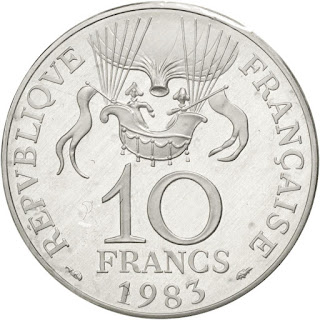France 10 Francs Silver Coin 1983 Montgolfier Balloon
Commemorative issue: 200th Anniversary of the Montgolfier Balloon
Obverse: below coin centre in two lines face value: 10 FRANCS; above a balloon gondola with brothers Montgolfier holding Colours; along the left edge: RÉPUBLIQUE, along the right: FRANÇAISE (French Republic); along the bottom edge year of issue 1983
Lettering: RÉPVBLIQVE FRANÇAISE 10 FRANCS 1983
Engraver: Daniel Ponce
Reverse: in the coin centre balloon "Réveillon" takes off among cheering crowd; along the top edge: CONQVÊTE DE L'ESPACE (Conquest of the skies), along the bottom edge date 1783
Lettering: CONQVÊTE DE L'ESPACE D.PONCE 1783
Engraver: Daniel Ponce
Edge: plain with concave inscription: LIBERTÉ ÉGALITÉ FRATERNITÉ (motto of France - liberty, equality, fraternity) divided by olive branch, laurel branch and cereal ear
Designer: Daniel Ponce (signature D.PONCE before date 1783 along the bottom edge of the obverse)
Mint: Paris Mint mark La Monnaie de Paris (The Paris Mint), Pessac (mint mark before year of issue 1983 in the obverse, after year of issue privy mark of mint's director Émile Rousseau - dolphin)
Mintage: 2 984 411 + 16 561 in annual boxed sets
Composition: Nickel-Bronze.
Diameter: 26 mm.
Weight: 10 gr.
The Montgolfier Brothers' Balloon
The first clearly recorded instance of a balloon carrying (human) passengers used hot air to generate buoyancy and was built by the brothers Joseph-Michel and Jacques-Etienne Montgolfier in Annonay, France. These brothers came from a family of paper manufacturers and had noticed ash rising in paper fires. The Montgolfier brothers gave their first public demonstration of their invention on June 4, 1783.
In collaboration with the successful wallpaper manufacturer Jean-Baptiste Réveillon, Étienne constructed a 37,500-cubic-foot (1,060 m3) envelope of taffeta coated with a varnish of alum (which has fireproofing properties). The balloon was sky blue and decorated with golden flourishes, signs of the zodiac, and suns. The design showed the intervention of Réveillon. The next test was on the 11th of September from the grounds of la Folie Titon, close to Réveillon's house. There was some concern about the effects of flight into the upper atmosphere on living creatures. The king proposed to launch two criminals, but it is most likely that the inventors decided to send a sheep, a duck, and a rooster aloft first.
On the 19th of September 1783, the Aérostat Réveillon was flown with the first living beings in a basket attached to the balloon: a sheep called Montauciel ("Climb-to-the-sky"), a duck and a rooster. The sheep was believed to have a reasonable approximation of human physiology. The duck was expected to be unharmed by being lifted aloft. It was included as a control for effects created by the aircraft rather than the altitude. The rooster was included as a further control as it was a bird that did not fly at high altitudes. This demonstration was performed before a crowd at the royal palace in Versailles, before King Louis XVI of France and Queen Marie Antoinette. The flight lasted approximately eight minutes, covered two miles (3 km), and obtained an altitude of about 1,500 feet (460 m). The craft landed safely after flying.
After experimenting with unmanned balloons and flights with animals, the first tethered balloon flight with humans on board took place on October 19, 1783 with the scientist Jean-François Pilâtre de Rozier, the manufacture manager, Jean-Baptiste Réveillon and Giroud de Villette, at the Folie Titon in Paris.
The first untethered, free flight with human passengers was on 21 November 1783. King Louis XVI had originally decreed that condemned criminals would be the first pilots, but de Rozier, along with the Marquis François d'Arlandes, successfully petitioned for the honor. For this occasion the diameter of the balloon rose to almost 50 feet with a smoky fire slung under the neck of the balloon placed in an iron basket, it was controllable and replenishable by the balloonists. In 25 minutes the two men traveled just over five miles. Enough fuel remained on board at the end of the flight to have allowed the balloon to fly four to five times as far, but burning embers from the fire threatened to engulf the balloon and the men decided to land as soon as they were over open countryside.
The pioneering work of the Montgolfier brothers in developing the hot air balloon was recognised by this type of balloon being named Montgolfière after them.

